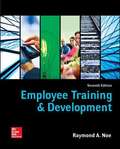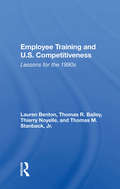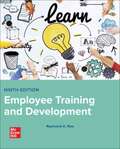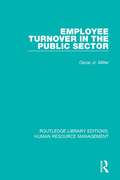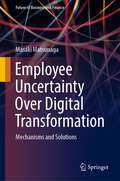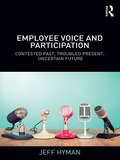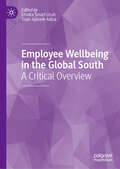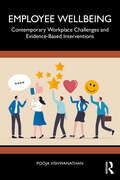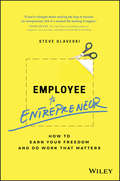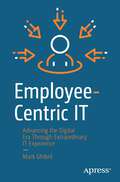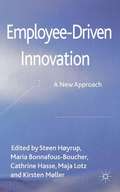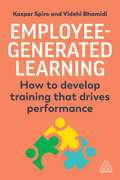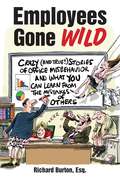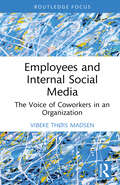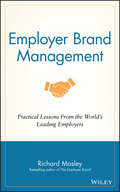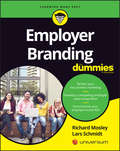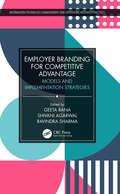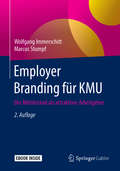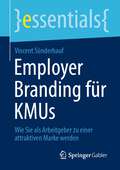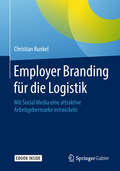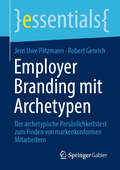- Table View
- List View
Employee Training And Development (Seventh Edition)
by Raymond Andrew NoeCompanies that use innovative training and development practices are likely to report better financial performance than their competitors that do not. Training and development also help a company develop the human capital needed to meet competitive challenges. Many companies now recognize that learning through training, development, and knowledge management helps employees strengthen or increase their skills directly impacting their job performance, satisfaction, and career advancement.
Employee Training And U.s. Competitiveness: Lessons For The 1990s
by Lauren BentonIt is by now commonplace to assert that the global economy is entering a new phase and that the paradigm of economic growth that was relevant to the early postwar decades no longer holds sway. Major changes, such as the explosive growth of services, the rise of a handful of highly successful newly industrializing countries, and the rapid expansion
Employee Training and Development
by Raymond Andrew NoeCompanies that use innovative training and development practices are likely to report better financial performance than their competitors that do not. Training and development also help a company develop the human capital needed to meet competitive challenges. Many companies now recognize that learning through training, development, and knowledge management helps employees strengthen or increase their skills directly impacting their job performance, satisfaction, and career advancement. The 9th edition covers and addresses the changes in training and development from an employer and employee perspective - adding value to the employer and employee. Based on the author's extensive experience in teaching training and development courses to both graduate and undergraduate students, Employee Training and Development, Ninth Edition, retains the lively writing style, inspiring examples, and emphasis on new technology and strategic training from previous editions.
Employee Turnover in the Public Sector (Routledge Library Editions: Human Resource Management #29)
by Oscar Miller, Jr.In this title, first published in 1996, the author uses the locus of control personality construct to show how workers who believe they can influence life events (internals) perceive and evaluate work conditions differently than workers who believe that life events are beyond their control (externals). The author also develops a social exchange model of quitting which takes advantage of the positive (job reward) and negative (job cost) qualities inherent in work conditions. Workers tend to quit their jobs when job costs outweigh job rewards when better alternatives exist. Moreover, personality interacts with employees’ evaluation of job costs and rewards and quitting behaviour. This book will be of interest to students of business studies and human resource management.
Employee Uncertainty Over Digital Transformation: Mechanisms and Solutions (Future of Business and Finance)
by Masaki MatsunagaThis book delves into the psychological and behavioral impact of the advent of digital transformation (DX) on white-collar employees in the modern organizational context. It uncovers how DX-driven uncertainty affects these workers' professional identity, self-efficacy, and job performance from a communication-centered perfective. While effective leadership can serve as a buffer, the intricate dynamics of these relationships await further exploration.To unravel these complex issues, the book employs an array of theoretical frameworks that have been tested against large, time-separated, dyadic datasets collected in Japan. In so doing, the studies introduced in this book illuminate how employees make sense of and communicate the uncertainties they face. Furthermore, it highlights a vision-driven leadership style and scrutinizes its unique attributes and limitations for addressing team members' uncertainty.This book is indispensable for executives and managers; it is a roadmap to steering digital transformation efforts without igniting resistance or conflict among frontline staff. For researchers, it's an invaluable resource for analyzing the mechanism of uncertainty management in today's fast-paced, tech-centric environments. Moreover, the book bridges the gap between interpersonal communication studies and other pivotal disciplines, such as leadership, management, organizational behavior, and social psychology in the context of stress and coping with uncertainty.
Employee Voice and Participation: Contested Past, Troubled Present, Uncertain Future
by Jeff HymanEmployee participation and voice (EPV) concern power and influence. Traditionally, EPV has encompassed worker attempts to wrest control from employers through radical societal transformation or to share control through collective regulation by trade unions. This book offers a controversial alternative arguing that, in recent years, participation has shifted direction. In Employee Voice and Participation, the author contends that participation has moved away from employee attempts to secure autonomy and influence over organisational affairs, to one in which management ideas and initiatives have taken centre stage. This shift has been bolstered in the UK and USA by economic policies that treat regulation as an obstacle to competitive performance. Through an examination of the development of ideas and practice surrounding employee voice and participation, this volume tracks the story from the earliest attempts at securing worker control, through to the rise of trade unions, and today’s managerial efforts to contain union influence. It also explores the negative consequences of these changes and, though the outlook is pessimistic, considers possible approaches to address the growing power imbalance between employers and workers. Employee Voice and Participation will be an excellent supplementary text for advanced students of employment relations and Human Resource Management (HRM). It will also be a valuable read for researchers, policy makers, trade unions and HRM professionals.
Employee Voice at Work (Work, Organization, and Employment)
by Peter Holland Julian Teicher Jimmy DonagheyThis book addresses the contemporary aspects of employee voice through theoretical and practical analysis. In addition to case studies of employee voice in the workplace, it also looks at emerging forms of voice associated with the use of technology such as social media. Because of the breadth of the concept of employee voice, the focus of the book lends itself to an international perspective on employment relations and human resources management – analyses and experiences drawn from one country will be usefully considered or applied in relation to others.
Employee Voice in the Global North: Insights from Europe, North America and Australia
by Toyin Ajibade Adisa Chima Mordi Emeka OruhTaking readers through the nature and realities of employee voice across the Global North, this book identifies the significance and effects of contexts, cultures, web and social media, and dissimilarity of institutional factors in enhancing employee voice or promoting silence. It addresses general issues affecting employee voice across the globe to give readers an understanding of employee relations that is country-specific. Readers will also have an understanding of the unique nature of employee voice in three continents – thus broadening the readers’ understanding of the subject. Covering employee voice in different countries of Europe, North America and Australasia, each chapter draws out the unique and diverse nature of employee voice in each country. The chapters discuss issues ranging from culture, activities of trade union, institutional factors, web and social media, social and organisational justice and their effects of employee voice. This book provides an invaluable resource for students and researchers of human resources and international business. It will also be of great interest to HRM practitioners, policymakers and business managers across the globe.
Employee Voice in the Global South: Insights from Asia, Africa and South America
by Toyin Ajibade Adisa Chima Mordi Emeka OruhTaking readers through the nature and realities of employee voice across the Global South, this book identifies the significance and effects of contexts, cultures, web and social media, and dissimilarity of institutional factors in enhancing employee voice or promoting silence. It addresses general issues affecting employee voice across the Global South to give readers an understanding of employee relations that is country-specific. Readers will also have an understanding of the unique nature of employee voice in thirteen countries – thus broadening the readers’ understanding of the subject. Covering employee voice in different countries of Africa, Asia and South America, each chapter draws out the unique and diverse nature of employee voice in each country. The chapters discuss issues ranging from culture, activities of trade union, institutional factors, web and social media, social and organisational justice and their effects of employee voice. This book provides an invaluable resource for students and researchers of human resources and international business. It will also be of great interest to HRM practitioners, policymakers and business managers across the globe.
Employee Wellbeing in the Global South: A Critical Overview
by Toyin Ajibade Adisa Emeka Smart OruhIn an increasingly globalised world, an understanding of the diversity in the concept and practice of employee wellbeing, how it is presented, experienced, regulated and contested, is particularly vital. This contributed volume presents studies from African, Asian and South American countries to paint a picture of employee wellbeing in the Global South, including the commonalities and points of difference across that broad context. The chapters not only capture the significance and impacts of contexts and cultures, but also, the different institutional environments that enhance or suppress employee wellbeing in employment relations. With a critical lens, this book explains how assumptions should not be made of employee wellbeing without a knowledge of the regional, national or local context. It will be of great interest to scholars and students of HRM, work and employment and international business.
Employee Wellbeing: Contemporary Workplace Challenges and Evidence-Based Interventions
by Pooja VishwanathanDrawing on work and positive psychology, this insightful book addresses contemporary workplace challenges and analyses evidence-based interventions in the employee wellbeing domain. Recent years have seen significant developments in the area of employee wellbeing, with many organisations becoming more interested in wellbeing at work. This book begins by contextualising employee wellbeing before and after the onset of the pandemic and demonstrates how employers are seeking advice and proactively implementing wellbeing policies and practices. It goes on to consider such issues as employee voice, employee growth mindset, burnout, quiet quitting, sleep hygiene, and psychological safety. Each chapter is supported by thought-provoking questions and activities that encourage readers to reflect on their learning and apply their understanding of the material in practice, as well as suggestions for further reading that offer resources for continued study. The book closes by analysing a range of specific interventions that organisations can employ, including potential pitfalls to avoid. In so doing, it offers clear, practical guidance for employers looking to improve employee wellbeing in their organisation. Employee Wellbeing is an important read for stakeholders within and outside of organisations, and will also be of interest to students and academics studying work psychology, organisational behaviour, wellbeing at work and related fields.
Employee to Entrepreneur: How to Earn Your Freedom and Do Work that Matters
by Steve GlaveskiMake the leap and become an entrepreneur today Are you living for the weekend? Are you dissatisfied at work? Are you itching to do something that is important to you? How can you avoid the pitfalls that many first-time entrepreneurs have fallen into? How do you explore whether entrepreneurship is right for you without giving up your day job? Employee to Entrepreneur is your guide to leaving your job behind and building something for yourself. Author and employee-turned-entrepreneur Steve Glaveski, shows you how to navigate the challenges, find the entrepreneurial success that is right for you and become a better person along the way. Employee to Entrepreneur combines storytelling with a step-by-step framework to teach you how to effectively explore and leverage entrepreneurship to gain freedom, fulfillment and financial security. understand what you want to do by first understanding yourself explore if entrepreneurship is right for you without giving up your day job avoid the common pitfalls faced by first-time entrepreneurs fund, test and prioritise your ideas in a fast and cost-effective way develop the mindset to succeed in your business. If you’re ready to leave your cushy employee life behind and build a business and a life you believe in, reading this essential guidebook is your first step to making it happen.
Employee-Centric IT: Advancing the Digital Era Through Extraordinary IT Experience
by Mark GhibrilGlobal surveys from McKinsey, BCG, Gartner, and others show that less than 30% of digital transformation programs succeed in their missions to improve a company’s performance and employee productivity. This is due to the fact that IT efforts within the company do not center around the employee. This book will provide concrete steps to allow both IT professionals and business leaders to transform the way they deliver IT to employees – with the employee (the human) centered in their transformation.The concepts, models, checklists, and playbook you'll review are based on the author's many years of experience, lessons learned, and proven outcomes. IT organizations want to improve their employee experience but don’t know how and this is the “must have” book for those who don’t know where to start. More than two-thirds of today’s jobs require good digital and IT skills from employees. The expectations of management, who invest in these big digital transformations, is that the employees will become more productive, effective and help the bottom line. However, this can only happen through active and proactive change of IT operations and transformations that center the employee, rather than technology or senior management. This book reveals the benefit of moving towards an approach where employees gain technology aptitude, are up for technology change, and are willing to learn more for their benefit and even provide feedback on ways to improve these tools, trainings and support. You'll see how employee engagement and experience research, concepts, and implementations are growing rapidly across many organizations and taking a key role in their global strategies. Employee-centric IT will transform employees to own their digital literacy and development, and this in turn reduces or even eliminates the shadow IT need and allows the organization to drive and implement successful digital transformation.What You'll LearnUnderstand the value of being employee-centric in IT departments versus current modelsTake steps to win IT team’s acceptance of the changes needed to achieve employee-centricityBe proactive in providing training & information on digital & productivity toolsWho This Book Is ForBusiness leaders, IT and digital leaders as well as IT employees who would like to transform their current IT and Digital teams to be more employee centric and drive highest level of value, adoption and satisfaction for their IT/digital programs, transformations and investment.
Employee-Driven Innovation
by Cathrine Hasse Steen Høyrup Maria Bonnafous-Boucher Maja Lotz Kirsten MøllerPresents research in Employee-Driven Innovation, an emergent field of study that meets the demand for exploiting new innovative potentials in organizations. There is a growing interest in creating new knowledge in innovation, emphasizing human resources and social processes. The authors intend to take the global lead in research on these areas.
Employee-Generated Learning: How to develop training that drives performance
by Kasper Spiro Videhi BhamidiDeveloping learning materials has traditionally been a slow and costly process, with updates being a constant challenge. How can organizations counter this problem?Most companies adopt a learning strategy where content is created by a centralized learning and development (L&D) department, with no input from existing employees. This process is slow, expensive and makes it impossible to keep content updated. The solution is shifting content creation from a top-down approach to a bottom-up one, allowing employees to share their knowledge across the business. This approach is called Employee-generated Learning. Through it, L&D professionals have more time to focus on learning strategy and culture, analytics, ROI and addressing any knowledge gaps. This book is a practical guide that explains what Employee-generated Learning is, the benefits of this approach and how to implement it. It provides a framework for organizations of any size, enriched by detailed how-to's, industry insights and case studies from companies that have successfully implemented this bottom-up approach. Employee-Generated Learning covers the shift in learning trends from formal to informal learning and from theoretical learning to performance support. It outlines the performance, financial and productivity gains from kickstarting a knowledge-sharing culture. Most importantly, it is a practical manual on implementing Employee-generated Learning step by step. The book is ideal for all learning professionals looking to upskill their workforce at pace, capture the knowledge and experience of their staff and improve both individual and business performance.
Employees First, Customers Second
by Vineet NayarOne small idea can ignite a revolution just as a single matchstick can start a fire.One such idea-putting employees first and customers second-sparked a revolution at HCL Technologies, the IT services giant.In this candid and personal account, Vineet Nayar-HCLT's celebrated CEO-recounts how he defied the conventional wisdom that companies must put customers first, then turned the hierarchical pyramid upside down by making management accountable to the employees, and not the other way around.By doing so, Nayar fired the imagination of both employees and customers and set HCLT on a journey of transformation that has made it one of the fastest-growing and profitable global IT services companies and, according to BusinessWeek, one of the twenty most influential companies in the world.Chapter by chapter, Nayar recounts the exciting journey of how he and his team implemented the employee first philosophy by: Creating a sense of urgency by enabling the employees to see the truth of the company's current state as well as feel the "romance" of its possible future state Creating a culture of trust by pushing the envelope of transparency in communication and information sharing Inverting the organizational hierarchy by making the management and the enabling functions accountable to the employee in the value zone Unlocking the potential of the employees by fostering an entrepreneurial mind-set, decentralizing decision making, and transferring the ownership of "change" to the employee in the value zoneRefreshingly honest and practical, this book offers valuable insights for managers seeking to realize their aspirations to grow faster and become self-propelled engines of change.
Employees Gone Wild: Crazy (and True!) Stories of Office Misbehavior and What You Can Learn from the Mistakes of Others
by Richard Burton Esq.Hilarious and hair-rising true tales of office debauchery from the lawyer who gets paid to clean up the mess. Try to imagine the following workplace scenarios: two employees having hot and heavy sex in an open cubicle in full view of their coworkers. A boss conducting a business meeting while wearing nothing but a strategically-placed towel. Employees using Craigslist to arrange sexual trysts with hookers on company time. Breast-flashing. Oral sex solicitation via office e-mail. Impossible? Unbelievable? Richard Burton has tales you won’t believe actually happened over his decades spent as the attorney hired by companies to protect them when their employees act out. Employees Gone Wild collects some of the most outrageous and absolutely-true stories (names changed to protect the guilty of course) from Burton’s years on the job, along with his indispensible practical advice on how companies and the people that work for them can avoid the same pitfalls. Hilarious and eye-opening in the same breath, dozens of cartoons give Employees Gone Wild a light tone perfect for the coworker with a sense of humor. It’s also a great excuse for anyone that’s received a slap on the wrist from their job: Hey, at least I’m not as bad as that guy!
Employees and Internal Social Media: The Voice of Coworkers in an Organization (Routledge Research in Public Relations)
by Vibeke Thøis MadsenThis book explores the benefits and challenges of employees communicating on internal social media (ISM) and how employee communication can develop and construct an organisation.Drawing from the latest research, the book identifies ISM's potential uses, such as sharing knowledge and viewpoints and connecting across departments, hierarchical levels and geographical distances. It argues that ISM can pave the way to create participatory and multivocal communication that can involve and engage employees in a different way than other internal communication channels. Further themes include strategic internal listening, the importance of open communication, and communicative leadership and coworkership. It features cases, examples and practical instructions to tie research into practice.This title is relevant to academics and practitioners in the fields of strategic communication and organisational communication.
Employer Brand Management
by Richard MosleyAttract, recruit, and retain the very best with a strategicemployer brand From one of the world's leading pioneers in the employer branddiscipline and author of the first book on the subject TheEmployer Brand, comes the long-awaited practical follow-upEmployer Brand Management. Talented, motivated employees area company's best assets, and the techniques in this book helpattract, recruit, and retain the very best. A successful employerbrand reaches beyond the boardroom to establish confidence,loyalty, and enthusiasm all the way down the ladder. EmployerBrand Management gives readers a personal grasp of a newapproach to people management. It draws on significant advances inpractices among leading companies to provide a handbook foremployer brand development and implementation. With a wide range ofcase studies and examples, you'll be taken step-by-step through theemployer brand development process. You will find information onthe latest developments in technology, with particular attentionpaid to socially-enabled recruitment marketing and employeecommunication and engagement.You will:Follow the process of brand planning, definition,implementation, and applicationDiscover how brand thinking can strengthen strategy andreinforce HR valueImprove existing recruitment and talent managementprogramsLearn the importance of employee engagement in the brandexperience
Employer Branding For Dummies
by Richard Mosley Lars SchmidtAttract the very best talent with a compelling employer brand Employer Branding For Dummies is the clear, no-nonsense guide to recruiting and retaining top talent. Written by the head talent warrior at Universum, this book gives you the hard facts and expert insight you need to build your brand as a great place to work. You'll learn how to research what makes your company stand out, the best ways to find the people you need, and how to convince those people that your company is the ideal place to exercise and develop their skills. The discussion includes ways to identify the specific traits that spell success at your company, and how to translate those traits into hiring metrics that only let the good ones through. You'll build and maintain your own distinctive, credible employer brand, and develop a set of relevant, informative Key Performance Indicators to help you keep the ball rolling. For most people, work is more than what they do — it's a part of who they are. This guide shows you how to discover and develop your employer brand to draw the quality talent you need. Create a distinctive employer identity Perfect your talent sourcing techniques Track the right Key Performance Indicators Recruit and retain the very best talent Face it: the very best employees are the ones with the most options. Why should they choose your company? A strong employer brand makes the decision a no-brainer. It's good for engagement, good for retention, and good for the bottom line. Employer Branding For Dummies helps you hone in on your unique, compelling brand, and get the people you need today.
Employer Branding for Competitive Advantage: Models and Implementation Strategies (ISSN)
by Shivani Agarwal Geeta Rana Ravindra SharmaThis book shows how to build and maintain a distinctive and credible employer brand and develop a set of relevant success metrics to help measure return on investment (ROI). Starting with the current interest in employer branding, this book looks at the historical roots of brand management and the practical steps to achieve employer brand management success.The book will review the pressures that have generated current interest in employer branding. It goes on to look at the historical roots of brand management and the practical steps necessary to achieve employer brand management success. The book includes the business case, research, positioning, implementation, management and measurement, and case studies of big-named employer brand stories.This book will provide new insights into the field of employer branding and provide directions and tools for organizational brand building. It will be beneficial for research scholars, engineers, practitioners, and management students.
Employer Branding für KMU
by Wolfgang Immerschitt Marcus StumpfEine attraktive Arbeitgebermarke ist in Zeiten des Fachkräftemangels das A und O im Personalmarketing. Gerade für kleine und mittelständische Unternehmen im internationalen Konkurrenzumfeld stellt die Rekrutierung und Bindung geeigneter Mitarbeiter eine besondere Herausforderung dar. Dieses Buch zeigt strukturiert auf, wie KMU erfolgreiche Arbeitgebermarken schaffen können, und bietet fundierte Grundlagen, zahlreiche Praxisbeispiele und 22 anschauliche Unternehmensfallstudien. Die 2. Auflage wurde umfassend überarbeitet und um aktuelle Fallbeispiele ergänzt. „Die vorliegende Publikation zeichnet sich dadurch aus, dass nicht nur eine theoretische Fundierung erfolgt, sondern anhand zahlreicher Praxisbeispiele und Fallstudien der Umsetzungsprozess und das Controlling des Employer Branding speziell für den Mittelstand sehr praxisnah dargestellt wird.“ Univ.-Professor Dr. Dr. habil. Wolfgang Becker, Direktor des Europäischen Kompetenzzentrums für Angewandte Mittelstandsforschung, Otto-Friedrich-Universität Bamberg „Wie sich KMU als attraktive Arbeitgeber profilieren, ohne dabei die budgetären Möglichkeiten zu überspannen, zeigt das vorliegende Buch anhand einer Vielzahl von Praxisbeispielen. Es regt nicht nur zum Nachdenken über Rekrutierung und Mitarbeiterbindung an, sondern bietet ganz konkrete Handlungshilfen." Mario Ohoven, Präsident des BVMW – Bundesverband mittelständische Wirtschaft, Unternehmerverband Deutschlands e.V.
Employer Branding für KMUs: Wie Sie als Arbeitgeber zu einer attraktiven Marke werden (essentials)
by Vincent SünderhaufDieses essential erklärt, wie Employer Branding funktioniert und wie insbesondere kleine und mittelständische Unternehmen ihren Weg zu einer erfolgreichen Arbeitgebermarke finden können. Denn in vielen Branchen sind Fachkräfte und Spezialisten hart umkämpft, doch genau von diesen Experten hängt oft der Erfolg der unternehmerischen Entwicklung ab. Firmen, die sich mitten im Kampf um qualifizierte Arbeitskräfte befinden, müssen es also schaffen, aus der konkurrierenden Menge hervorzustechen und im War for Talents wirkungsvoll zu agieren. Insbesondere für mittelständische Unternehmen gibt es viele Chancen, ihre Arbeitgebermarke zu stärken und sich auf dem Markt begehrt zu machen – kompakte Tipps und Empfehlungen dazu bietet dieses essential.
Employer Branding für die Logistik: Mit Social Media eine attraktive Arbeitgebermarke entwickeln
by Christian RunkelDieses Buch vermittelt praxisnah am Beispiel der Logistik Branche, wie Unternehmen die Attraktivität ihrer Arbeitgebermarke mit einer Social-Media-Strategie langfristig steigern können, um dem Fachkräftemangel dauerhaft entgegenzuwirken. Denn ohne eine zielgruppenorientierte Kommunikation der eigenen Employer Brand kann Recruiting in der heutigen Zeit kaum gewährleistet werden.Auf Basis praxisbewährter Beratungskonzepte stellt der Autor zunächst die Grundlagen von Employer-Branding-Projekten vor, beschreibt Lösungsansätze und zeigt zusätzlich drei Fehler auf, die man bei Employer-Branding-Projekten begehen kann. Da insbesondere Social-Media-Kanäle helfen können, eine positive Wahrnehmung als Arbeitgeber zu etablieren sowie die Bekanntheit zu steigern, werden die wichtigsten Social-Media-Plattformen thematisiert.
Employer Branding mit Archetypen: Der archetypische Persönlichkeitstest zum Finden von markenkonformen Mitarbeitern (essentials)
by Jens Uwe Pätzmann Robert GenrichPersönlichkeitstests sind im Kontext der Personaldiagnostik und -entwicklung gut erforscht und in der Praxis eingesetzt, jedoch beschäftigen sich bisher wenige Autoren mit dem konkreten Einsatz von Persönlichkeitstests für ein zielgerichtetes Employer Branding.In diesem essential finden Sie einen neu entwickelten archetypischen Persönlichkeitstest, mit dem potenzielle Mitarbeiter auf Markenkonformität und bestehende Mitarbeiter auf Markenbotschaftereignung getestet werden können.
